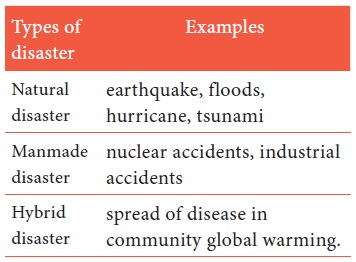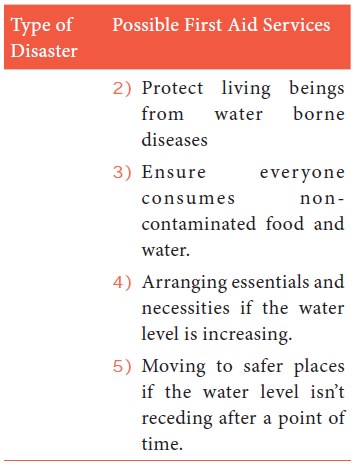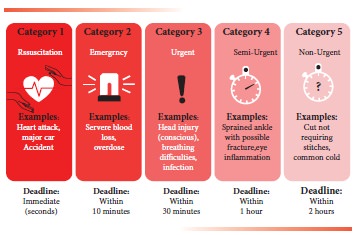First Aid - Disaster | 11th Nursing : Chapter 9 : First Aid
Chapter: 11th Nursing : Chapter 9 : First Aid
Disaster
Disaster
A disaster is a sudden calamitous event that seriously disrupts
the functioning of a community or society and causes losses that exceeds the
community or societys ability to cope using its own resources.
Red Cross (1975) defines Disaster as “An occurrence such as
hurricane, tornado, storm, flood, high water, wind-driven water, tidal wave,
earthquake, drought, blizzard, pestilence, famine, fire, explosion, building
collapse, transportation wreck, or other situation that causes human suffering
or creates human that the victims cannot alleviate without assistance.”
DISASTER’ alphabetically means:
D - Destructions
I - Incidents
S - Sufferings
A - Administrative, Financial Failures.
S - Sentiments
T - Tragedies
E - Eruption of Communicablediseases.
R - Research programme and its implementation
Types of disaster

Classification of First Aids during Disasters



The first aid immediately after a disaster may consist of the following-
1)
Attending to the individuals who have broken limbs, bones and
apply local massage therapy.
2)
Disinfecting the body parts/areas where there has been minor
bruises with antiseptic and then plastering those areas with bandage.
3)
Attending the parts having burns.
4)
Putting in place a working communication system.
5)
Prevent the spread of contaminated food and drinking water.
6) Provide post-accident
SOS support services to all the affected individuals.
Disaster Triage
The word triage is derived from the French word trier, which means, “to sort out or choose.”
Types of Triage
There are two types of
triage:
1.
Simple triage
2.
Advanced triage
Simple Triage
Simple triage is used
in a scene of mass casualty, in order to sort patients into those who need
critical attention and immediate transport to the hospital and those with less
serious injuries.
S.T.A.R.T. (Simple
Triage and Rapid Treatment) is a simple triage system that can be performed by
lightly trained lay and emergency personnel in emergencies.
Triage separates the
injured into four groups:
·
0 – The deceased who are beyond help
·
1 – The injured who can be helped by immediate transportation
·
2 – The injured whose transport can be delayed
·
3 – Those with minor injuries, who need help less urgently
Advanced Triage
Advanced care will be
used on patients with less severe injuries. Because treatment is intentionally
with held from patients with certain injuries
It is used to divert
scarce resources away from patients with little chance of survival in order to
increase the chances of survival of others who are more likely to survive.
Principles of advanced
triage is
·
“Do the greatest good for the greatest number”
·
Preservation of life takes precedence over preservation of
limbs.
Advanced Triage Categories
CLASS I (EMERGENT) RED IMMEDIATE
Victims with serious
injuries that are life threatening but has a high probability of survival if
they received immediate care.
They require immediate
surgery or other life-saving intervention, and have first priority for surgical
teams or transport to advanced facilities; they “cannot wait” but are likely to
survive with immediate treatment.
“Critical;lifethreatening—compromised
airway, shock, hemorrhage”
CLASS II (URGENT) YELLOW DELAYED
Victims who are
seriously injured and whose life is not immediately threatened; and can delay
transport and treatment for 2 hours.
Their condition is
stable for the moment but requires watching by trained persons and frequent
re-triage, will need hospital care (and would receive immediate priority care
under “normal” circumstances).
“Major illness or
injury;—open fracture, chest wound”
CLASS III (NON-URGENT) GREEN MINIMAL
“Walking wounded,” the
casualty requires medical attention when all higher priority patients have been
evacuated, and may not require monitoring.
Patients/victims whose
care and transport may be delayed 2 hours or more.
“minor injuries;
walking wounded— closed fracture, sprain, strain”
CLASS IV (EXPECTANT) BLACK EXPECTANT
They are so severely
injured that they will die of their injuries, possibly in hours or days
(large-body burns, severe trauma, lethal radiation dose), or in
life-threatening medical crisis
that they are unlikely
to survive given the care available (cardiac arrest, septic shock, severe head
or chest wounds);
They should be taken
to a holding area and given painkillers as required to reduce suffering.
“Dead or expected to
die—massive head injury, extensive full-thickness burns”

Related Topics